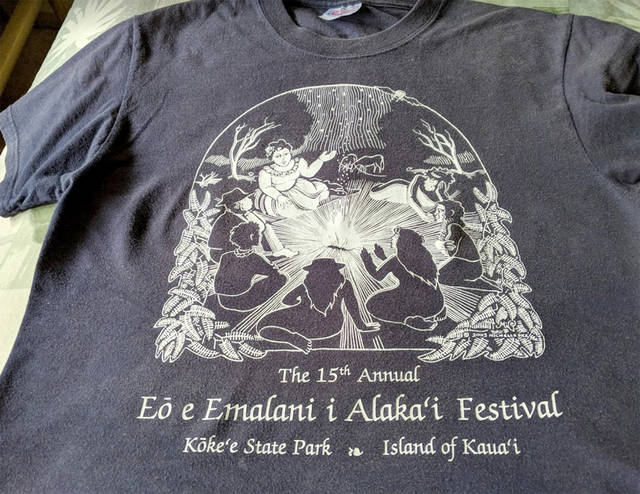Speaking of diversity — the focus of the last “Green Flash” (Oct. 8) — the meaning of that word boomeranged back to me in Kokee as I enjoyed watching and being part of the Eo e Emmalani i Alakai Festival in honor of the beloved Hawaiian Queen Emma Naea Rooke and her 1871 upland trek with 100 friends into the Alakai Swamp area. What an array of dancers and chanters, musicians, cultural vendors and environmental educators, Hui O Laka/Kokee Natural History Museum workers, and festival goers gathered for the public event!
The sight of so many people of varying backgrounds all cooperating happily in the spirit of the queen who is so revered for her loving, helpful — and explorative — spirit was, for lack of a better word, uplifting.
This recent festival, and all the others I’ve had the privilege of attending over the years, was once again unforgettable. As October approaches each year, it’s something many look forward to — a beautiful, gentle time, a time to learn and celebrate goodness and cooperative humanity, beauty of the Hawaiian culture and way of being. A time to travel mauka (mountainward), to breathe the pure, cool air, to hug and honi (kiss, inhale scent) with family, friends and acquaintances, to leave “the grid” behind as cell phones and interruptions of thought and spirit are quiet, and to truly enter into a shining, peaceful window to history of this place.
“I felt that this is where Hawaiian people could come to truly learn and celebrate (a part of) their history,” Anette Jelen-Csokay told me. She had traveled from Vienna, Austria, with dancers of her European branch of the Ka Imi Institute halau hula (hula school) to join in Ka Imi’s combined presentation.
While relaxing, watching, listening and learning in the green meadow, time always seems to elongate. Co-founder and Mistress of Ceremonies (MC) Roselle Keliihonipua Bailey in one of her trove of educative tidbits offered between halau hula presentation remarked, “Time is a commodity” in our present day and age. The MC has an exacting job as time-keeper, so that each group involved is assured of a fair share of presentation time and the overall festival timing stays on track.
Because all the gifts of hula, mele and oli (song and chant) that are presented to the reigning “queen” in this public event are from the heart and non-competitive, this infuses the day with a special glow. The non-profit Hui O Laka Board and members with full cooperation from their invited participants have striven to keep it this way, following the protocol of the true historic time of the actual Queen Emmalani riding into the meadow. How thrilling it is to welcome the elegant queen as she arrives on horseback accompanied by her guide playing Kaluahi (the original guide for the queen’s trek) and her kumu hololio (horse-riding head attendant).
This year’s choice to represent the queen, Sharalyn Kahealani Bucasas, joins a long line of women, each of whom has been carefully chosen because of her outstanding presence and work for the betterment of others within the community. And as to diversity, looking back at the list of previous 29 festival queens, the surnames read as a global stew, from Filipino and Spanish, British and European, Asian, Polynesian including Hawaiian — an affirming stew attesting to the richly mixed gene pool of our island people.
Which takes us to consider an oft-quoted message of King David Kalakaua, another visionary ruler of the Hawaiian Kingdom, who clearly stated that, “Our people will be a new breed.” He understood that there would be intermarriage in Hawaii as a true crossroads of the Pacific, that the Hawaiian and Polynesian bloodlines would mix with other bloodlines, resulting in the strong, handsome citizenry of today. He also gave the underlying message that this was not a dilution of strength, but the opposite, and that the “new breed” he spoke of would carry forward the true values of the Hawaiian culture rooted in respectful reverence of the island aina (earth) and sustainability for its “flowers” — the people, and not forgetting the spiritual aspect of humanity.
That prediction was evident once again in the Kanaloahuluhulu Meadow on this October’s second Saturday, the day set for the Emmalani Festivals, past and future.
The day dawned clear, fresh and sunny — a gift between rainy, chilly times. The Kokee Museum workers and volunteers had set up awnings and decorated designated areas the afternoon before; they arrived back early to set the finishing touches. (The word is out that worker-bees as well as contributors would be welcomed for any of the varied and important museum educational forest projects, including Eo e Emmalani i Alakai 2019. There is also the Forest Bird Recovery Project and others needing support.)
During one hula presentation following midday, a dancer lifted her hands toward the position of the sun in the meadow, only to see her fingertips pointing to the amazing drifts of our famous mountain lii lii (mist) that suddenly arrived as a blessing, lingered and teased, then disappeared as quickly as it came. Magical. Touching. Ephemeral … like the annual festival.
Festival footage is readily available to view on the internet and in DVDs sold at the Kokee Museum Shop. To become a member of Hui o Laka in support of the work of preserving, protecting and educating within the Kokee Forest of Waimea Canyon State Park, you may access membership and other information at www.kokee.org or write to Hui o Laka, P.O. Box 100, Kekaha, HI 96752.
•••
Dawn Fraser Kawahara, author and poet, made her home on Kauai in the 1980s. She and her husband, a retired biology teacher, live with books, music and birds in Wailua Homesteads. Shared passions are travel and nature. The writer’s books may be found in local outlets and on Amazon. For further information, tropicbirdpress@gmail.com.


